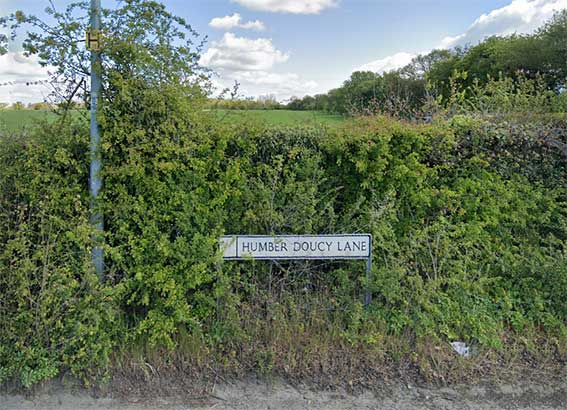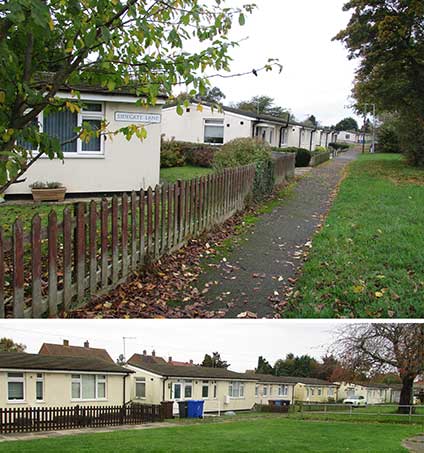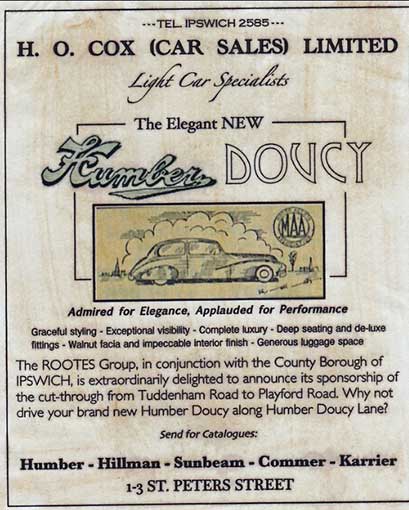Humber Doucy Lane
Above: the street nameplate on the
north-west corner of the junction with Rushmere Road.
In 2024, the derivation of this road's name remains a
topic of
conversation on social media and elswhere*. We thought it was time that
Humber Doucy Lane deserved its own web-page. Running north-west from
Playford Road, crossing Rushmere Road, eventually to reach Tuddenham
Road, much of it runs alongside and within the Ipswich Borough
boundary. It is a curious, meandering sort of lane with an equally
curious
name, which initially puzzled us. The derivation soon became clear and
we deal with it in detail on our Street
name derivations page.
(*June 2025: see a major revision on our Street
name derivations page.)
Talking of meandering, there was a stream along much of Humber
Doucy Lane until it was culverted when it was built up. Trees and
bushes would have grown up. We can conjecture that there was a footpath
alongside the stream which became a cart track. It must have been
common land here originally, resembling the heath and grassland of
Rushmere Heath on either side of the main road to Kesgrave. From the
1750s enclosure by parliamentary Act became the norm, creating fields
and hedgrows. The track would have become a useful lane to link farms,
field accesses, cottages and linking radial roads from the town
(Playford, Rushmere, Tuddenham Roads). The
section of Humber Doucy Lane between Rushmere Road
and Sidegate Lane would have been quite busy with carts and carriages
avoiding the toll house*opposite The
Golden Key. That is, until The Side Gate toll-point was installed on
Sidegate Lane, hence the name.
(*For more on The Ipswich To South Town (Yarmouth) & Bungay
Turnpike Trust on our Milestones page.)
Since the later 20th century, sadly the length of this lane has become
best known as a traffic rat-run.
 2023 image
2023 image
Above: the modern metal street
nameplate (with the Borough coat of arms at left completely faded by
the sun) in a setting opposite the junction with Sidegate Lane gives us
a glimpse of the character of the lane post-enclosure of the fields.
The building of the first Ipswich Bypass
(Colchester Road, Valley Road, Chevallier Street, Yarmouth Road) led to
the development of housing, mainly in the 1930s (some of it by the Freehold Land Society), plus subsequent estates
such as Dumbarton/Renfrew Roads.
Below: the section of the lane
between Playford Road and Rushmere Road has been given 'heritage'-style
street signs with the Borough coat of arms above in the shaped metal
plate. The view on the left shows that the sign on the junction with
Rushmere Road retains its colour because of the shade provided by the
trees. The sign on Playford Road junction is faded by the sun. Planting
of shrubs and clipping of the grass shows that locals care for these
signs.
 2023 images
2023 images
Incidentally, the Borough arms appear again nearer to
Seven Cottages Lane at the entrance to Ipswich Rugby Football Club (see
our Borough coat of arms page for many more
examples). Seven Cottages Lane itself is an
interesting street name. We assume that it refers to the terrace of
cottages a few hundred yards form the junction with Humber Doucy Lane.
However, the refurbished dwellings (which look as if they were all
modernised at the same time) boast eight front doors. It's difficult to
work out if one of the end cottages have been added at some time. There
don't appear to be any other dwelling fronting onto the lane if one
continues right dow to its junction with Tuddeham Lane and Lamberts
Lane.
Pre-fabricated dwellings
(pre-fabs)
 2024 images
2024 images
Above: lines of pre-fabs along Humber Doucy Lane from the north-west
corner of the Sidegate Lane junction; below that, nearby pre-fabs on
Sidegate Lane.
'Pre-fabricated dwellings (‘pre-fabs’) came into their own immediately
after the Second World War, when the returning service personnel needed
accommodation, and needed it quickly. One of the key builders of
pre-fabs was the aircraft industry. A large number of factories had
been
geared up for aircraft production during the war effort and they were
able to turn their hand to mass producing housing, typically aluminium
bungalows but also two storey steel framed dwellings.
'In 1942 the immediate threat of invasion had passed and so attention
turned to the possibility of post-war housing, even at that stage it
was estimated that some 3 to 4 million new homes would be required. The
pressure was on the Government (even though housing was a local
authority responsibility) thus it was the Government that decided and
promoted pre-fabs.
In 1944 prime minister Winston Churchill announced the commencement of
a Ministry of Works emergency temporary, factory-made housing programme.
• Emergency – immediately after the war there was a lack of skilled
building workers.
• Temporary – to persuade the public to accept lightweight (instant)
construction.
• Factory – made by selected manufacturers (some of whom also erected
the pre-fabs).
'However, the passing of time confirmed that the majority of pre-fabs
were not temporary but were to last typically 40 to 50 years.
Churchill’s temporary housing programme of 156,000 homes were built
between 1945 and 1949. Designed to last 10 or 15 years, a surprising
number remain today, including those in Inverness Road, Ipswich. The
term pre-fab encompasses a range of different construction methods from
homes that arrived complete on the back of a truck to system built
houses that required the wall infill materials to be added using either
local materials or, in some cases asbestos, corrugated steel sheeting
or concrete panels.
'In Ipswich pre-fabs were constructed in Bramford Lane and off Sidegate
Lane, in a variety of different formats. The 150 bungalows in Inverness
Road and Humber Doucy Lane were Tarran Bungalows and have survived for
some 65 years.
Tarran Industries of Hull was a private construction company that had
been involved in pre-fabrication since the mid 1930s. Tarran was the
contractor for the Quarry Hill flats in Leeds city centre built in
1935, the largest pre-war experiment in pre-fabrication. During the war
Tarran supplied more than 9,000 prefab timber huts to the War
Department and by 1943 was exhibiting its single storey concrete mark
III model. It had walls of sawdust concrete and a flat roof covered
with three layers of bitumen felt. Robert Tarran announced to the press
that his company could manufacture 100,000 per year.
'Tarran bungalows were framed structures with bolt-on concrete panels.
As an exercise to get the public to accept pre-fabs as homes in which
to
live likely residents were invited to contribute to the design process.
Asking the public for a contribution was almost unheard of either
before or during the war. This was however very much along the lines of
‘you can have it any colour you want as long as it’s black’ ie. you can
contribute to the discussion on the number of kitchen cupboards but
you’ll still have to live in a pre-fab!' (From John Norman's Ipswich Icons article, East Anglian Daily Times, February
12, 2015)
It may be remembered that, a few years ago, a proposal was made within
Suffolk County Council to remove the pre-fabs in Ipswich and to use the
land for 'proper' houses. Needless to say, the occupants who love their
pre-fabs were strongly opposed to this and the proposal was eventually
dropped.
Local advertising, 1930
The name of the lane was seized upon by the local car dealership H.O.
Cox in this
'stretching-credibility' advertisement which was discovered by Ed Broom
(see Links for Freston.net) in the souvenir
programme for the 1930 Wolsey Pageant
held in Ipswich. This is an excellent source because it enables us to
date it precisely.
 1930 image courtesy Ed Broom
1930 image courtesy Ed Broom
H.O. Cox had its showroom on the northern part of St
Peters Street –
across Rose Lane from The Rose Hotel – on
what has becaome known as 'Wolsey Plain' because of its sculpture of Thomas Wolsey. It would have
been on the site of Lord Curson's house,
which played an important role in the story of Wolsey's College. A 1970s aerial view
taken by John Bulow-Osborne of this location appears on our Sailors rest page in an update (9.12.14)
showing the partially-obscured H.O. Cox showroom.
The Wolsey Pageant was initially staged in 1927. The
Wolsey Art Gallery
opened in 1932, a permanent memorial of the celebrations of the Wolsey
Pageant which was held in Ipswich to mark the four hundredth
anniversary of the Cardinal’s death in November 1530.
Home
Please email any comments
and contributions by clicking here.
Search Ipswich
Historic Lettering
©2004
Copyright
throughout the Ipswich
Historic Lettering site: Borin Van Loon
No reproduction of text or images without express written permission


 2023 image
2023 image 2023 images
2023 images 2024 images
2024 images 1930 image courtesy Ed Broom
1930 image courtesy Ed Broom